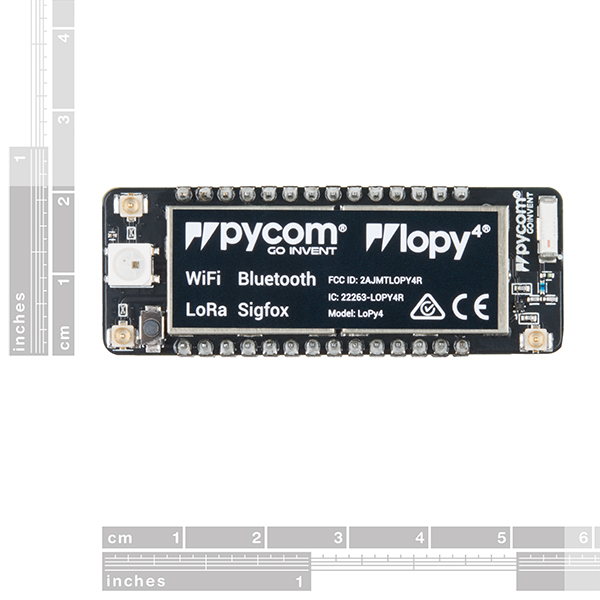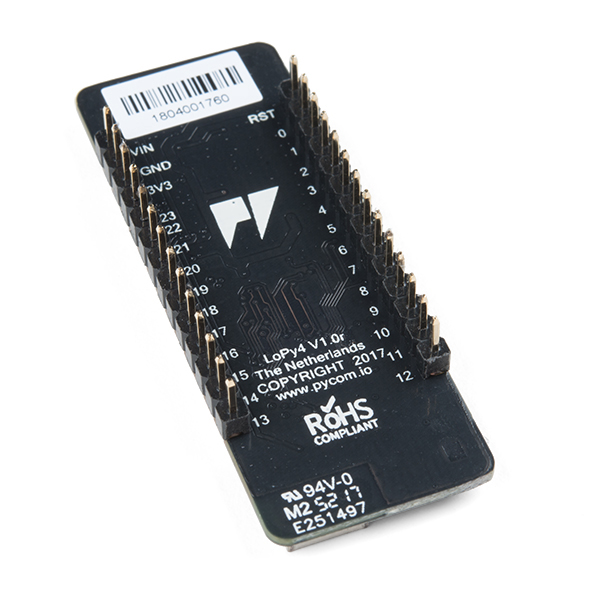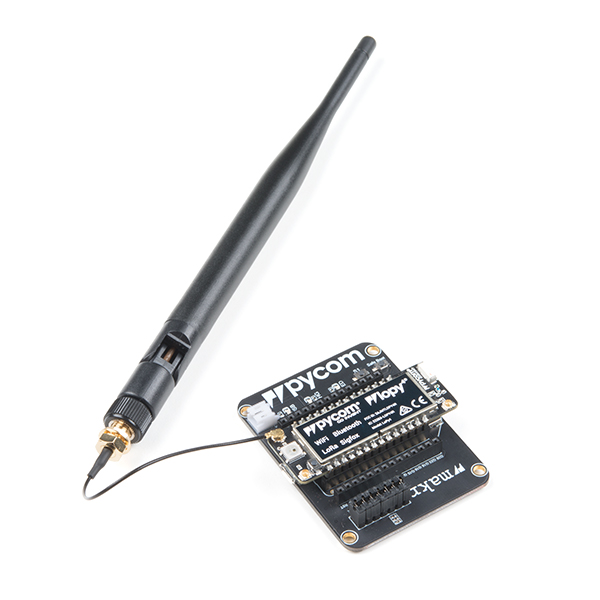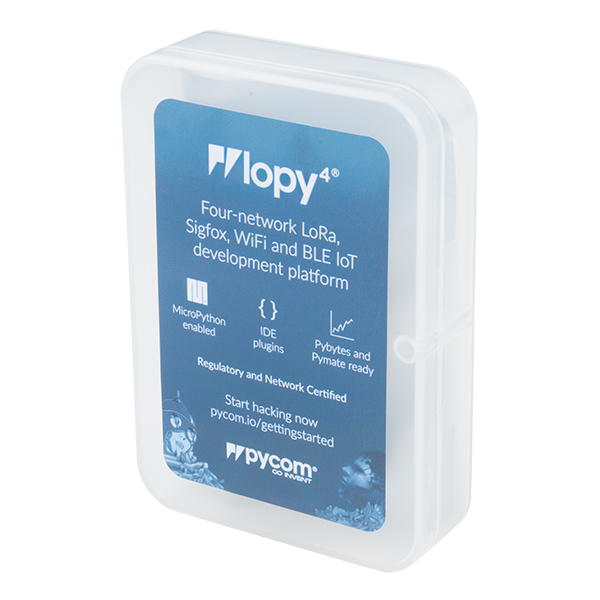Pycom LoPy4 Development Board
The LoPy4 is a compact quadruple network MicroPython enabled development board (LoRa, Sigfox, WiFi, Bluetooth). It’s the perfect enterprise-grade IoT platform for your connected Things. With the latest Espressif ESP32 chipset the LoPy4 offers a perfect combination of power, friendliness, and flexibility. Create and connect your things everywhere. Fast.
The LoPy4 can act as a LoRa nano gateway and a multi-bearer (LoRa, Sigfox, WiFi and BLE) development platform suitable for all LoRa and Sigfox networks around the globe. It is programmable with MicroPython and the Pymakr plugins for fast IoT application development, easy programming in-field and extra resilience with network failover. You can also configure the LoPy4 in raw LoRa mode to send packets directly between LoPy4’s. The best blend of speed to deployment and access to new LPWAN networks rolling out across Europe, USA, Africa and India. The LoPy4 is CE, FCC approved, LoRaWAN and Sigfox certified.
Note: Using the LoRa or Sigfox radio without the external antenna can lead to damage of the device and is therefore not recommended.
- Powerful CPU, BLE and state of the art WiFi radio
- Can also double up as Nano LoRa gateway
- MicroPython enabled
- Fits in a standard breadboard (with headers)
- Ultra-low power usage: a fraction compared to other connected micro controllers
- Espressif ESP32 chipset
- Dual processor + WiFi radio System on chip
- Network processor handles the WiFi connectivity and the IPv6 stack
- Main processor is entirely free to run the user application
- An extra ULP-coprocessor that can monitor GPIOs, the ADC channels and control most of the internal peripherals during deep-sleep mode while only consuming 25uA
- Sigfox Specification
- Class 0 device. Maximum Tx power:
- RCZ1 – 868MHz, +14dBm (Europe)
- RCZ2 – 902MHz, +20dBm (Americas)
- RCZ4 – 920-922MHz, +20dBm (Australia and New Zealand)
- Node range: Up to 50km
- Sigfox certified
- LoRa Specification
- Semtech LoRa transceiver SX1276
- LoRaWAN stack
- Class A and C devices
- 868 MHz (Europe) at +14dBm maximum
- 915 MHz (North and South America, Australia and New Zealand) at +20dBm maximum
- 433 MHz (Europe) at +10dBm maximum
- 470 – 510 MHz (China) at +14dBm maximum
- Node range: Up to 40km
- Nano-gateway: Up to 22km
- Nano-gateway capacity: Up to 100 nodes
- 2 x UART, SPI, 2 x I2C, I2S, micro SD card
- Analog channels: 8×12 bit ADCs
- Timers: 4×16 bit with PWM and input capture
- DMA on all peripherals
- GPIO: Up to 24
- RAM: 4MB
- External flash: 8MB
- Hash / encryption: SHA, MD5, DES, AES
- WiFi: 802.1b/g/n 16mbps
- Bluetooth: Low energy and classic
- RTC @ 32kHz
- Power
- Input: 3.3V – 5.5V
- 3v3 output capable of sourcing up to 400mA
- WiFi: 12mA in active mode, 5uA in standby
- LoRa: 15mA in active mode, 1-uA in standby
- Sigfox (Europe): 12mA in Rx mode, 42mA in Tx mode and 0.5uA in standby
- Sigfox (Australia, New Zealand and South America): 12mA in Rx mode, 120 mA in Tx mode and 0.5uA in standby
Pycom LoPy4 Development Board Product Help and Resources
How to Load MicroPython on a Microcontroller Board
September 4, 2018
This tutorial will show you how to load the MicroPython interpreter onto a variety of development boards.
Core Skill: Programming
If a board needs code or communicates somehow, you're going to need to know how to program or interface with it. The programming skill is all about communication and code.
Skill Level: Competent - The toolchain for programming is a bit more complex and will examples may not be explicitly provided for you. You will be required to have a fundamental knowledge of programming and be required to provide your own code. You may need to modify existing libraries or code to work with your specific hardware. Sensor and hardware interfaces will be SPI or I2C.
See all skill levels
Core Skill: Electrical Prototyping
If it requires power, you need to know how much, what all the pins do, and how to hook it up. You may need to reference datasheets, schematics, and know the ins and outs of electronics.
Skill Level: Rookie - You may be required to know a bit more about the component, such as orientation, or how to hook it up, in addition to power requirements. You will need to understand polarized components.
See all skill levels
Comments
Looking for answers to technical questions?
We welcome your comments and suggestions below. However, if you are looking for solutions to technical questions please see our Technical Assistance page.
Customer Reviews
4 out of 5
Based on 1 ratings:







Is it programmable using arduino IDE? Is the radiohead library compatible with this one ? Thanks.